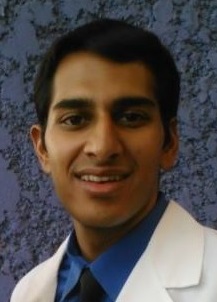Arka Chaudhury, OMS II at A.T. Still University-SOMA Awarded $5,000 TOMF Founders' Scholarship
May 27, 2015
 Arka Chaudhury, OMS II from Phoenix, has a strong interest in physical medicine and rehabilitation. He started his career as a bio-engineer and loved studying and understanding the intricacies of the human body but something was missing. "In the engineering realm there is no accounting for a mind and spirit," he says, but won't discard his engineer's skills completely, especially problem-solving skills, in exchange for a physician's armamentarium. "A problem solver has to see more than just the facts, " he says, "A diagnosis can never be as simple as just looking at the facts of patient symptoms and labs...the true art to being a problem solver is to be able to adapt to variables and make necessary considerations." We asked Arka a few questions about his path to medicine, his daily life as an osteopathic medical student and his future endeavors as an osteopathic physician. Read on to find out more about him.
Arka Chaudhury, OMS II from Phoenix, has a strong interest in physical medicine and rehabilitation. He started his career as a bio-engineer and loved studying and understanding the intricacies of the human body but something was missing. "In the engineering realm there is no accounting for a mind and spirit," he says, but won't discard his engineer's skills completely, especially problem-solving skills, in exchange for a physician's armamentarium. "A problem solver has to see more than just the facts, " he says, "A diagnosis can never be as simple as just looking at the facts of patient symptoms and labs...the true art to being a problem solver is to be able to adapt to variables and make necessary considerations." We asked Arka a few questions about his path to medicine, his daily life as an osteopathic medical student and his future endeavors as an osteopathic physician. Read on to find out more about him.1. What is your hometown?
My hometown is Phoenix, AZ.
2. What caused you to choose medicine as a career?
Medicine was revealed to me as a career option late in my undergraduate education. I was studying bioengineering at the University of California, San Diego. During my junior year, I realized the part of my classes that I enjoyed the most was the direct application of what I was learning to patients and the clinical world. That was when I decided research and academia was not what I wanted to invest my time in, but the actual treatment and application of the science to a patient population to help better one's quality of life.
3. Which specialty do you plan to practice?
I am not sure what specialty I want to practice yet. But I currently have a strong interest in Physical Medicine and Rehabilitation.
4. What does your typical school day look like?
Because of how A.T. Still University's curriculum is set up in 2nd year, there isn't a typical "day" per say. But through a week, we have anywhere from 10-20 hours of podcasts to watch for class, 4 hours of Osteopathic Manipulative Treatment instruction, 4 hours of Medical Skills, 4 hours of case studies in small groups, and a full day working at an El Rio clinic with a physician.
5. What qualities do you look for in a mentor or role model?
The qualities I look for most in a mentor are level-headedness, dependable, and empathetic.
6. As a mentor and role model yourself, what advice would you give to a student considering medicine as a career?
The number one piece of advice I would give to a student considering medicine is to properly evaluate if medicine is what they truly have a passion for and to truly understand what they are signing up to endure.
7. What is the most interesting thing you've discovered so far in your medical training?
The most interesting thing I've learned is how little we as a scientific community really know. The more that I've learned about specific diseases makes me question another aspect of the disease and how there can be so many clinical presentations of the same disease. For every answer that research provides there seems to be at least 3 more questions to be asked to delve deeper into the problem.
8. What are you most excited about doing after you become a physician?
I'm most excited about to be able to have a greater sense of responsibility and ability to provide a service to the community.

